In Part 3, we'll take a look at the dynamic range of the G10 and D-LUX 4 (LX3) cameras at base ISO compared to the Sigma DP1 in a real world application.
Dynamic range test results can often be confusing. Two reputable sites will use the same method, such as Imatest, and come up with significantly different results. There are rarely practical examples shown to demonstrate the detected differences. Furthermore, dynamic range testing is often done on in-camera JPEGs, so the information gained doesn't reflect the entire sensor capability and is of limited practical use to a primarily RAW shooter.
Recently, DxOlabs have begun to publish sensor tests which are performed on the RAW data and adjusted for matched output size. Their methods appear to be sound. According to their data, the LX3 has 11.03 stops of dynamic range at a manufacturer ISO of 100, versus 10.03 stops for the G10 at manufacturer ISO 80 and 9.64 stops for the G10 at manufacturer ISO 100. A decrease of 1EV corresponds to a halving of dynamic range. DxOmark did not report the dynamic range of the LX3 when set to ISO 80. It may be that the base ISO for the LX3 corresponds to a manufacturer ISO of 100, in which case a lower expanded ISO setting of 80 would be expected to sacrifice highlight DR. This is a possibility to keep in mind since my tests below were performed at manufacturer ISO 80 for both cameras, potentially depriving the LX3 of optimal performance.
My method for testing dynamic range is pretty straightforward. I take a single photo of a high DR scene, one which exceeds the DR capability of the camera sensor. I then "push" the image to +2EV and examine the shadow detail. Next, I adjust the same image to -2EV and look at the highlight information. The ability of the camera to simultaneously capture both the shadow and highlight detail from a challenging scene can thus be determined in a practical manner. The next two paragraphs have the boring, technical details:
In the following comparison, the G10 and LX3 were both set to manufacturer ISO 80, 1/10s, and f/4. The DP1 was set to manufacturer ISO 100, 1/15s, and f/4. DxOmark found an approximate one stop disparity between the measured and reported (manufacturer) ISO at any given setting on the LX3, though they did not report on the ISO 80 setting. Using Raw Developer to process all files, I do not see this disparity between levels in processed G10 and LX3 files at any given ISO, meaning that one of the following is the case: 1) DxOmark ISO measurements are significantly faulty (unlikely); 2) Manufacturer settings for aperture and/or shutter speed are inaccurate (unlikely but possible); or 3) Somewhere in the processing pipeline, the LX3 data is getting pushed to the appropriate exposure index. #3 seems most likely to me, but I have no means to test this assumption.
I processed the G110 and D-LUX 4 RAW files in Raw Developer (Iridient Digital, latest version, Mac only), while the DP1 file was processed in Sigma Photo Pro. Noise reduction and sharpening were disabled in Raw Developer. G10 and D-LUX 4 files were downsized to the diagonal dimension of the DP1 native output.
Here is the overall (resized) G10 image prior to any exposure adjustments in Raw Developer: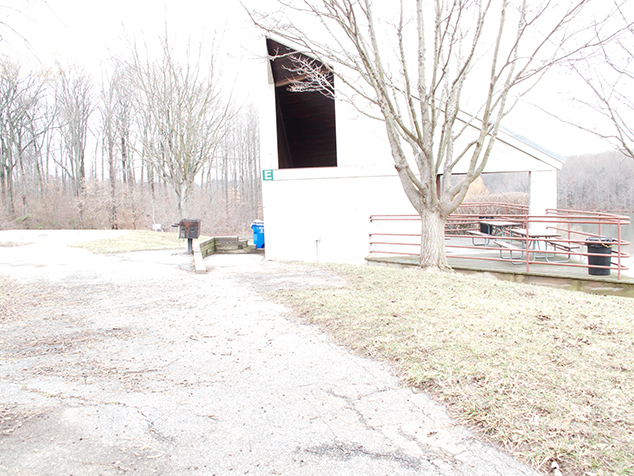
Here is the overall (resized) LX3 image prior to any exposure adjustments in Raw Developer: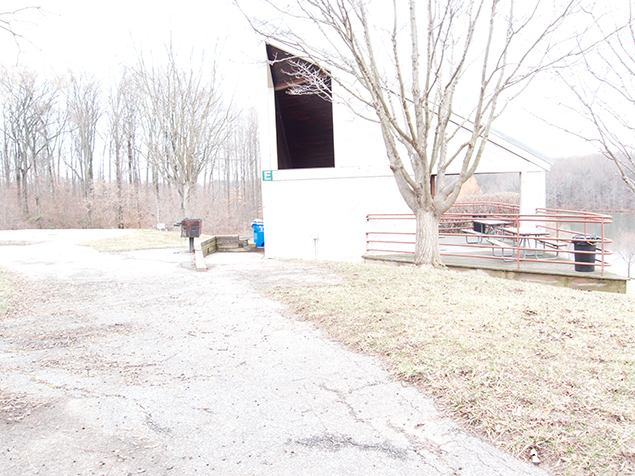
The D-LUX 4 processed RAW angle of view is slightly wider here than that of the Canon since I matched the D-LUX 4 JPEG angle of view to that of the G10.
Here is the overall (resized) DP1 image prior to any exposure adjustments in Sigma Photo Pro: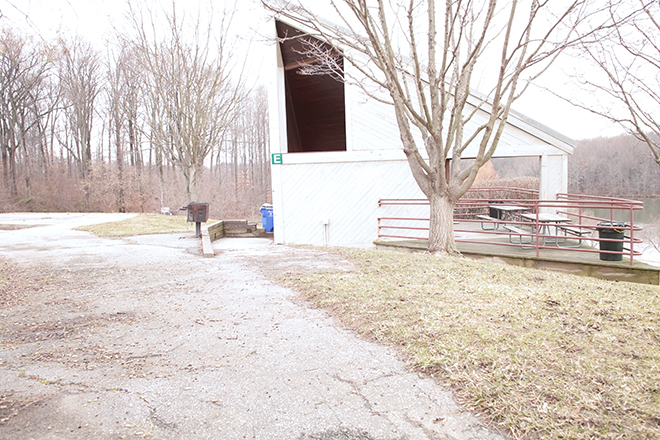
It is clear that, prior to adjustment, the DP1 shadows are and highlights appear less clipped than those of the other two cameras. This correlates with my experience that, prior to any work done in a RAW converter, DP1 files show great dynamic range.
Next let's look specifically at the highlight regions, before and after a -2EV adjustment: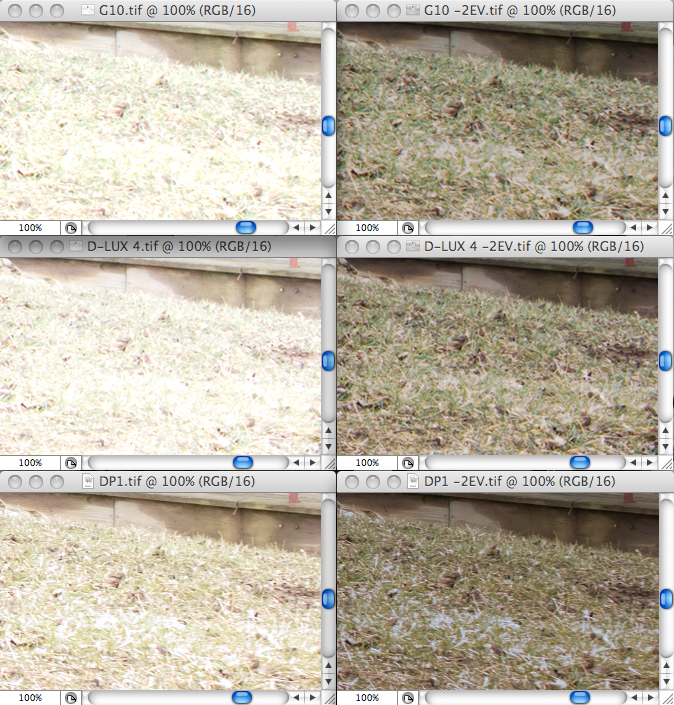
Again, at this magnification we can see that the small sensor cameras appear to have blown the highlights to a greater extent than the DP1. However, looking at what can be recovered with a -2EV adjustment, the D-LUX 4 has had the greatest recovery of highlight information. By comparison, the G10 and DP1 are both unable to recover from highlight clipping. It is more obvious in the case of the DP1, which loses all color in clipped areas. Overall, this part of the test is consistent with my experience that the DP1 resists highlight clipping in general, but not much headroom is available for recovery when highlight information appears to have been lost.
Next let's look specifically at the shadow regions, before and after a +2EV adjustment. I have adjusted the colors and contrast after the +2EV adjusted crops to roughly match one another.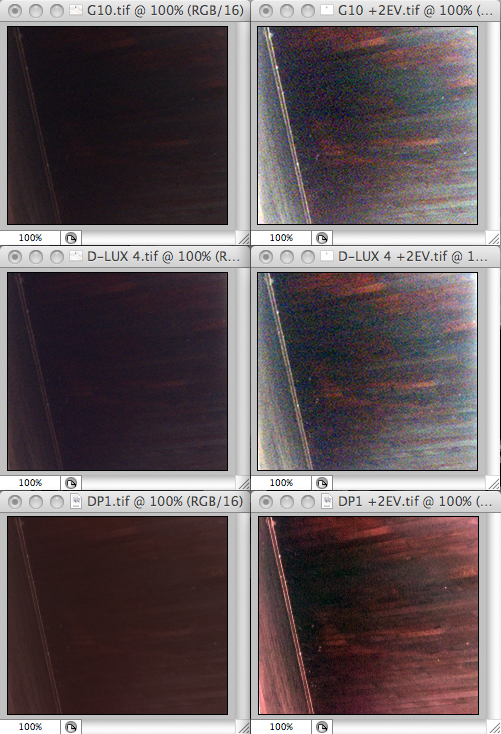
The DP1 is clearly superior with regards to shadow detail. The G10 and D-LUX 4 have a similar result, with the D-LUX 4 coming out slightly ahead.
Overall, this test shows slightly higher dynamic range for the D-LUX 4 as compared with the G10. I found the dynamic range advantage of the D-LUX 4 over the G10 to be noticeable in practice. However, neither camera approaches the overall dynamic range of the DP1.
Here are the RAW files for your examination:
In Part 4, we'll look at the low light, high ISO performance of the G10 and D-LUX 4.
Canon G10 - Leica D-LUX 4 Shootout Pt. 3: Dynamic Range
Wednesday, December 24, 2008
Canon G10 - Leica D-LUX 4 Shootout Pt. 3: Dynamic Range
2008-12-24T08:54:00-05:00
Amin
Subscribe to:
Post Comments (Atom)
Recent Posts
-
▼
2008
(254)
-
▼
December
(10)
- Panasonic G1 - Nikon D700 ISO Shootout
- Panasonic G1 Size Comparisons
- Canon G10 - Leica D-LUX 4 Shootout Pt. 3: Dynamic ...
- Canon G10 - Leica D-LUX 4 Shootout Pt. 2: Field of...
- Canon G10 - Leica D-LUX 4 Shootout Pt. 1: Design a...
- Panasonic and Adobe - The Case Against DNG
- Raw Developer 1.8.2 Released
- GRD II Review, Supplement
- Ricoh GR Digital II Review
- DC Watch Comparison of GX200, P6000, G10, and LX3
-
▼
December
(10)

